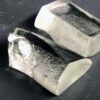An accidental discovery in a research project is to be examined further and may result in completely new methods for designing.
Topology optimization is a recognized design method that makes it possible to create completely new design structures. The method has, for example, been used by DTU’s researchers to demonstrate new and lighter design options for a number of structures, including aircraft wings and the bridge deck on suspension bridges. This is achieved by letting a supercomputer distribute the material in a defined area divided into tiny ‘building blocks’ known as voxels. Each voxel can either be filled with material or be ‘air,’ thus providing complete freedom for creating a new design.
Until now, it has not been possible to apply the design method to structures that have one or more internal contact points where part of the structure comes into contact with another part of the structure under load. This obstacle now seems to have been overcome.
“We’ve discovered by chance that—in the work with topology optimization—it is possible to compress the ‘air’ in a voxel to an extreme degree. This suddenly makes it possible for the ‘air’ in the simulations to transmit the contact forces in the same way as they would occur in reality. This means that topology optimization can be used to design structures with internal contact points,” says Associate Professor Konstantinos Poulios, who is part of DTU Mechanical Engineering’s internationally recognized research group in topology optimization: the TopOpt group.
Practical applications
Based on the new knowledge, the researchers at DTU have received funding for a project—TOPCON—the purpose of which is to develop the new method further. As there is already a proof of concept documenting that the method works, the next step is to make it more robust and effective for large calculations.
“In addition, we will examine to which products this type of topology optimization is applicable during the design phase. We already have a number of options in mind for which we need to explore the potential further,” says Konstantinos Poulios.
They include the part of a robot that is to grab and hold on to an object. Or the soles of a pair of running shoes, which should preferably be so solid that the runner avoids injuries while also ensuring that as little energy as possible is lost when the foot hits the ground and subsequently pushes off again.
More information:
Gore Lukas Bluhm et al, Internal contact modeling for finite strain topology optimization, Computational Mechanics (2021). DOI: 10.1007/s00466-021-01974-x
Provided by
Technical University of Denmark
Citation:
Accidental discovery may revolutionize method for designing structures (2021, December 14)



